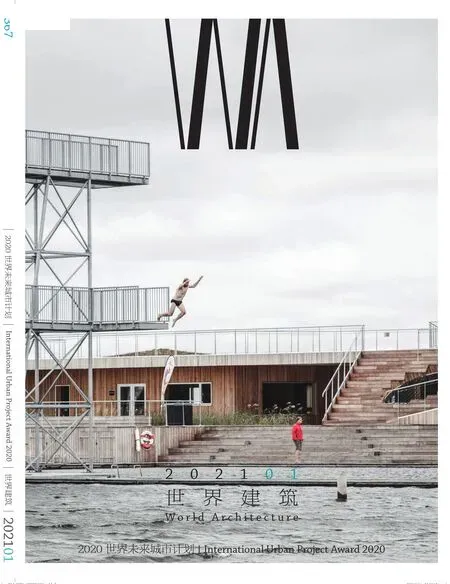从三场设计竞赛窥见保罗·克瑞公民建筑中的社会责任意识
伊丽莎白·格林威尔·格罗斯曼/Elizabeth Greenwell Grossman
潘丽珂 译/Translated by PAN Like
本文1-2)[1]最初是2019年10月12日在清华大学的一次研讨会上所作的演讲,恰逢当时的展览 “归成——毕业于宾夕法尼亚大学的中国第一代建筑学家”。本文思考了法裔美国建筑师保罗·P·克瑞的工作(1876-1945,图1),他教授了许多中国学生,不仅讲授了他的设计方法,尤其,传达了他关于美好社会的理念。我认为,克瑞致力于设计公民建筑——图书馆、博物馆、政府大楼和纪念馆——不仅因为这是鲍扎建筑师所接受的训练,更是因为他深信这些建筑对社会有重要作用。第一次世界大战期间,克瑞在法国军队服役时,写信给妻子道:“我担心自己正在失去长久以来获得的那点东西,而那正是我的社会价值。”换言之,对克瑞而言,巴黎美院的学习使他能够教授并实践建筑,而这正是他为社会做出贡献的方式,或者用他自己的话讲,这赋予他“社会价值”。
克瑞的社会价值观不仅在于设计实用和适用的建筑,他最希望通过设计这样的建筑鼓励公民参与到公民事务中来。
克瑞的职业生涯由他在竞赛中获得的成功所形成。在本文中,我将讨论其中的3场竞赛,通过比较克瑞与其他参赛者的作品来强调克瑞独特的设计手法。首先从1907年华盛顿特区的泛美联盟总部大楼竞赛的获胜讲起,这场竞赛使克瑞蜚声全国。当克瑞参与竞赛时,他刚刚接受宾夕法尼亚大学建筑学院提供的教职工作不久,当时他在美国仅待了5年。
要理解泛美联盟总部大楼竞赛所提出的难点,需要简单回顾一下该机构的历史。该建筑的目的是为一个新机构提供场地,而该机构旨在促进美国与拉丁美洲共和国之间形成更好的关系。最初,该建筑只是为了存放被称为“哥伦布纪念图书馆”的资料,这些藏书旨在增进知识,从而增进美国与拉丁美洲成员国之间的了解(图 2、3)。
然而到了比赛阶段,业主对该建筑的雄心大大增加了——不仅要求做一个“堂皇的”图书馆,而且还要求有一个巨大的集会空间。竞赛简讯还专门要求建造一个庭院,但并未明确说明使用哪种类型的建筑,不过曾提及“家园”和“和平神庙”等概念。
将克瑞的获胜作品与其他一些参赛作品相比较,可以清晰获知他赢得竞赛的原因。这些比较也阐明了他在职业生涯中反复使用的鲍扎设计策略。
豪威尔斯和斯托克斯的立面以其圆顶和柱廊著称(图4、5),但克瑞避免使用这些公共建筑的传统标志,而改用能唤起拉丁美洲建筑记忆的瓦屋面。他的入口采用了3个带装饰格栅的拱形门洞,这也暗示了出入大楼的人流组织不那么正式。简而言之,他的设计让人联想到一个家,而非一个宏伟的机构。
克瑞的平面也很独特(图6、7)。与凯利尔和黑斯廷斯将集会厅构思成一个布满座位的礼堂不同,克瑞提出了法国人能立即理解的宴会厅概念——一种与大型房间中的聚会和社交活动相关的房间类型。更重要的是,这类房间使用起来十分灵活。它可以用作讲演和会议以及更多的节日聚会 (图8)。相较凯利尔和黑斯廷斯的设计,克瑞的平面更为紧凑。他不需要线性走道将房间连接在一起,而是引导游客在景观中穿越建筑,这些景观从庭院一直延续到前花园。
在首层平面图中,克瑞对该方案的策略被最戏剧性地揭示出来(图9、10)。图书馆要求有3个小房间——地图室、一个期刊室和一个阅览室。然而,克瑞将这3个房间合并成一个大房间,并用书柜来划分功能。通过这种方式,他创造出一个不仅仅满足于任务书实用性要求、而且可以真正值得称为“哥伦布纪念图书馆”的空间。
克瑞对图书馆的处理方式是他全部作品的典型,也是他整个设计的关键(图11)。从剖面图中可以清晰地看到,位于花园前端的图书馆为首层的漫游路径提供了有力的收尾,也为二层更为宽敞的集会厅提供了适当的支撑。
克瑞对剖面进行了精心设计,他表示:
“一个好的平面设计是可以凭之以良好的顺序竖立起良好的房间,因此它的检验在于剖面。剖面是整个构图的图解,并且应该是它的来源。”
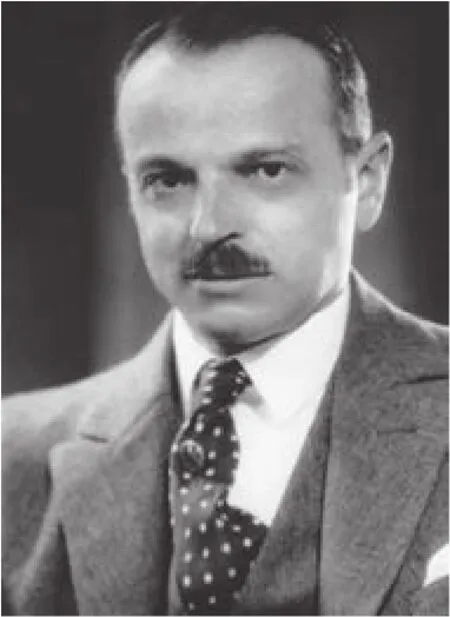
1 保罗·P·克瑞/Paul P. Cret1-2)

2 克瑞,泛美联盟总部大楼(OAS大楼),华盛顿特区,1910年,正立面/Cret, Pan American Union (OAS Building),Washington D. C, 1910, façade

3 泛美联盟总部,内部/Pan American Union, interior
This paper1-2)[1]was initially given as a talk in a symposium at Tsinghua University on October 12, 2019,in the occasion of the exhibit "Accomplishment - The First Generation of Chinese Architects from the University of Pennsylvania. It considers the work of French-American architect Paul P. Cret (1876-1945, Fig. 1) who taught many of these Chinese students, in terms of both his approach to design and most particularly, Cret's ideas of the good society. I argue that Cret's commitment to designing civic buildings - libraries, museums,government buildings and memorials - was not only because that is what Beaux-Arts architects were trained to do. I think Cret dedicated himself to civic buildings because he believed deeply in their importance to society. He wrote to his wife when he was serving in the French army during World War I that he was worried that he was "loosing that little which I was so long in gaining and which is my social value." In other words,for Cret his study at the Ecole des Beaux-Arts, which enabled him to teach and practice architecture, was his way of contributing to society, or to use his words, what gave him his "social value".
Cret's idea of social value was not just about designing functional and appropriate buildings. Cret wanted nothing less than to design buildings that would encourage citizens to participate in the civic sphere.
Cret's career was shaped by his successes in competitions. In this paper I discuss three of these competitions so as to underscore his particular approach to design by comparing Cret's entries with those of other competitors. I start with his winning entry in 1907 for the Pan American Union building in Washington D.C. which brought him to national recognition. When Cret entered the competition he had only recently accepted an invitation to join the faculty of School of Architecture, the University of Pennsylvania.He had been in the United States for only five years.
To understand the difficulties posed by the Pan American Union Building competition requires a very brief recounting of the history of this institution. The purpose of the building was to provide accommodation for a new agency created to promote better relations between the United States and the republics of Latin America. Originally, the building was just to house what was called The Columbus Memorial Library, a collection intended to advance knowledge and thus understanding among the USA and the member Latin American republics.
By the time of the competition, however, the ambitions for the building had increased signi ficantly -the programme called not only for a "digni fied" library but a large room for assemblies. The competition brief also called speci fically for a patio but it did not make clear what type of building was wanted. A "home" and a "temple of peace" were both mentioned (Fig. 2, 3).
Comparison of his winning entry with those of a few of the other entrants demonstrates quite clearly why Cret won. These comparisons also illuminate the Beaux-Arts design strategies that he used over and over again in his career.
Whereas Howells and Stokes' elevation is notable for its dome and colonnade (Fig. 4, 5), Cret avoided these conventional markers of public buildings and instead used a tile roof evocative of Latin American architecture. His entrance of three arched openings with decorative grilles also suggests a less formal flow of people to and from the building. In short, his design evokes a home rather than a grand institution.
Cret's plans are also distinctive (Fig. 6, 7). Unlike Carrère and Hastings who conceived their assembly room as an auditorium with fixed seats, Cret, in contrast, proposed what the French would recognize instantly as a salle de fête-a room type associated with gatherings and social events in great houses importantly the uses of this room are flexible. It could be used for lectures and meetings as well as for more festive gatherings (Fig. 8). In comparison with Carrère and Hastings, Cret's plan is much more compact. He has no need for linear corridors to knit the rooms together.Instead he invites visitors through the building with vistas that extend through the patio to the garden front.
It is in the first-floor plan that the Cret's approach to the program is most dramatically revealed (Fig. 9, 10).The requirements for the library called for 3 small rooms-one for maps, one for periodicals and one for reading. Cret however, united the three rooms into one large room with bookcases dividing the functions.By doing so he was able to elevate the status of the library beyond the utilitarian spaces that the program suggested to create a room that is actually worthy to be called the Columbus Memorial Library.
His approach to the library is typical of Cret's oeuvre and is the key to his whole design (Fig. 11). Clearly visible the section drawing, the library on the garden front provides a worthy conclusion to the first-floor promenade through the building and an appropriate support for the more lavish assembly room above.
Cret deliberately designed in section. He said:
"A good plan is one from which may rise good rooms in a good sequence its test therefore lies in the section. The sections are the diagram of the whole composition and ought to be its source."
For Cret designing in section was not just a useful skill but, in fact, a key to his efforts to help citizens to feel that civic institutions belonged to them.
In the final design the relation between the two floors was adjusted and perhaps, most importantly, the patio wall was redesigned as a dramatic diagonal cut so that one could look down into the patio from the stair case (Fig. 12). In turn, from the patio the diagonal of the staircase walls revealed the location of stairs and dramatised the ascent to the second floor. The building opens itself so effectively that led by the vistas and light, visitors can find their way around the building as easily as if it were their own home (Fig. 13, 14).
Cret was told that he won the competition because of his "judgment in making it a great private house, unlike others which had large amphitheatres with domes and injured the appearance of their plans by showing a multitude of seats." (Fig. 15, 16)
Significantly, when Cret explained his design he spoke about the public's experience of the building:
"The public is to be accommodated more like guests in a large residence than like the crowds attending paid functions in a public hall."
This is an early and very important statement of Cret's conception of the role of civic architecture. Civic buildings were to make the public feel at home.
Throughout his career, he would avoid monumental domes, imposing staircases, single-purpose rooms and tiresome corridors. He avoided them because he thought of the people who would visit the building, and the people who would work there. As he said:
"The architect must put himself in the place of the future occupant of the building, as the actor on the stage tries to live the character he is called on to impersonate."
In 1919 when Cret entered the post-war Nebraska State Capitol competition, he had just returned from France after 5 and 1/2 years of warfare - serving first as an infantryman in the trenches, and then as an interpreter on U.S. General Pershing's staff (Fig. 17, 18). As a soldier he had witnessed firs-hard some of the most terrible battles of that terrible war. By the time he resumed his teaching at the University of Pennsylvania he was 45 years old and partially deaf from the impact of the ammunition shells exploding over the trenches.The Nebraska competition was his first major design challenge after a long hiatus.
The Pan American Union competition, which had established Cret's national reputation, had required competitors to define the character of a completely new and unique institution. That was not the case with the Nebraska State capitol competition. State capitols were an established institutional type; they imitated the U.S. Capitol building in Washington, D.C with its de fining dome, and classical style (Fig. 19, 20).
Interestingly, in spite of the program language,only two architects among the competitors offered a completely new capitol type. One was Cret, the other was Bertram Grosvenor Goodhue. Both of them also understood that the key to the new type lay in the site,which was that of the old capitol. That building featured a dome positioned at the crossing of two streets at the centre of a four-block square in the Nebraska street grid.
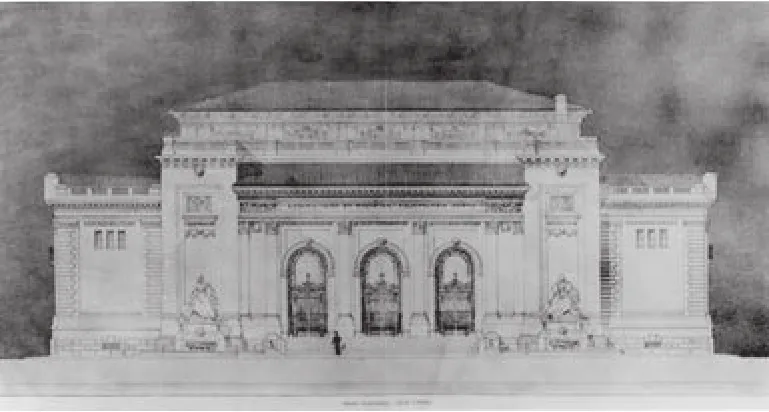
4 克瑞,泛美联盟总部竞赛,1907年,立面/Cret, Pan American Union competition, 1907, elevation

5 豪威尔斯和斯托克斯,泛美联盟总部竞赛,1907年,立面/Howells and Stokes, Pan American Union competition, 1907,elevation
对于克瑞而言,剖面设计不仅是一项有用的技能,事实上,这也是他帮助公民意识到这些机构属于他们的关键。
在最终设计中,克瑞调整了两层之间的关系,也许最重要的是,将庭院的墙体重新设计成富有戏剧性的斜线切口,这样人们就可以在楼梯上俯瞰庭院(图12)。同样的,置身庭院中往上看,楼梯墙的斜切揭示楼梯的位置,并戏剧性地展示了通往二层的上升路径。该建筑在景和光的引导下显得十分开放,游客在其中穿行自如,就像在自己的家中一样(图13、14)。
克瑞被告知他之所以赢得竞赛,因为他“将该建筑设计成一个大型私人住宅,不像其他参赛者将之设计成大型的圆形剧院,这些‘剧院’带有典型的穹顶,并且因为布置了过多的座位破坏了平面的图案关系”(图15、16)。
值得注意的是,当克瑞解释他的设计时,他谈到了公众对它的体验:
“公众在这个建筑中被‘款待’,更像大型住宅中的客人而非公共大厅中参加付费活动的人群。”
这是克瑞关于公民建筑概念早期且非常重要的陈述。公民建筑要让公众感到宾至如归。
纵观克瑞的职业生涯,他总在避免使用纪念性的穹顶、宏伟的楼梯、单一功能的房间和令人厌倦的走廊。他避免使用这些元素,因为他考虑到了今后来这里参观和在里面工作的人。正如他所说:
“建筑师必须设身处地考虑建筑将来的使用情况,正如舞台上的演员要将自己所扮演的角色演活一样。”
城市河岸不仅能够带动沿河地区的经济发展,甚至对整个城市的经济发展都起到显著的提升作用。其滨水住宅带来土地价值上涨,旅游、休闲、娱乐文化对沿河地区乃至整个城市的第三产业经济发展起到重要的促进作用。此外,由河流廊道带来的自然景色及活动场所有助于城市居民身心健康发展,具有重要的潜在社会经济价值。
1919年当克瑞参加战后的内布拉斯加州议会大厦竞赛时,他刚结束在法国为时5年半的战争生活——这些年里他先是在战壕中当步兵,然后成为美国潘兴将军的口译员(图17、18)。作为一名士兵,他亲眼目睹了这场可怕战争中一些最残酷的战役。当他再次在宾夕法尼亚大学执教时已经45岁了,并因在战壕里长期遭受弹药的轰炸而部分耳聋。内布拉斯加州议会大厦竞赛是克瑞战后第一个重大的设计挑战。
泛美联盟总部竞赛确立了克瑞的全国声誉,该竞赛要求参赛者定义一种全新和独特的机构特征,但内布拉斯加州议会大厦并非如此。议会大厦是一种既定的机构类型;它们常以圆顶和古典风格来模仿华盛顿特区的美国国会大厦(图19、20)。
出乎意料的是,内布拉斯加州议会大厦竞赛要求建筑师重新考虑这一传统。该竞赛简讯声明:“一州的议会大厦是其人民品格的外在标志。在内布拉斯加州,让新的议会大厦成为象征。”更明确的是,参赛者被邀请“面向建筑更广泛的遗产”。换句话说,该竞赛鼓励建筑师提供一种州议会大厦主流形式之外的替代方案。因而克瑞在这场竞赛中可能提出了一个新的范例。
有趣的是,尽管竞赛的简讯声明如此,但在众多参赛者中仅有两名建筑师提出了全新的议会大厦类型。一个是克瑞,另一个是贝特拉姆·G·古德休。同时他们也明白,新类型创造的关键在于基地,那里有旧议会大厦。该建筑带有圆顶,坐落于内布拉斯加州街道网格中一个四街区广场中心的两条街道交叉口。
然而在克瑞的设计中,没有采用圆顶来宣告这是一个州议会大厦(图21、22)。事实上,他并没有在街道交叉口设置显著的标志,而是在广场中心留下一片空地,将立法会议厅、最高法院和中央纪念大楼放在了基地外围各自独立的建筑中。在广场的开敞一侧,他放置了著名的雕塑——亚伯拉罕·林肯,该雕塑出自丹尼尔·切斯特·法兰奇之手,并且原先就位于场地上。克瑞的构图以巨大的方尖碑为背景,令人想起华盛顿特区的华盛顿纪念碑,他的构图就像传统的州议会大厦一样唤起人们对国家首都的记忆。
有趣的是,竞赛计划要求对设计进行“分解构图”。大多数参赛者用这张详图仅为了传递更多建筑风格的信息。然而,克瑞画了一个小场景,使他的设计意图更为生动:前景中拄着拐杖的人物暗示了从战争中回来的受伤士兵,方尖碑将位于纪念建筑檐壁上的“平等”字样隔离出来,这个词令人想起士兵们为之奋斗的理想,更具体地说,是内布拉斯加州“法律面前人人平等”的座右铭(图23)。
克瑞没有赢得竞赛——他获得第四名。古德休凭借他的“平原之塔”赢得了竞赛——该设计象征了教堂般飞升天堂的梦想(图25、26)。这座122m高的塔楼在37km的平地范围内可见,成为了城市的显著标志,并以一个巨型尺度的入口向公民致意。
古德休的设计向内布拉斯加州的公民展示了鼓舞人心的精神寄托,而克瑞则为他们提供了集会的场所,令人回想起美利坚合众国刚成立时低调的城市广场。正如其总平面图清晰显示(图24),他的议会大厦尽管3面封闭,但在北界面却打开了豁口,对着一所公立大学。因此,克瑞的设计强调了一种美国式信念,即加强对受过教育的公民和民主政府之间的联系。
该设计还揭示了克瑞关于教育对个人和社会的双重作用的价值信仰。
克瑞对教育的投入部分来自自身经历。他成长于法国里昂的一个工人阶级家庭,依靠自身出色的表现获得奖学金,从而完成了学业。这段个人经历使他对擅用职权的人表现出极大的厌恶。在战壕中,他写信给妻子,讲述了他对那些“维护和扩大自己特权”的精英的厌恶。克瑞看见他们利用自己的职位牟取更多私利而不是为选举和委任他们的人民服务,这种行为破坏了共和政府的制度。我认为很重要的一点是,作为一名建筑学的教授,克瑞本可以在第一次世界大战中免于返法服役,但他却选择参军并以一名普通的步兵身份加入。
对于克瑞而言,建立在特权基础上的社会恰恰与精英统治相反,在精英统治中,人们是基于个人才能和成就得到认可的。这不仅是简单的个人机会的问题,而且是要确保最好的想法能得到倾听,最佳的方式是要根据想法本身的优点来做决定而非决策者的地位。克瑞在讲座的笔记和信件中倡导“公正”和“摆脱个人偏见”,并明确警告学生摒弃“思想上的专制主义”,因为这会限制思维,从而干扰寻求社会问题最佳解决方案的努力。

7 凯利尔和黑斯廷斯,泛美联盟总部竞赛,1907年,平面/Carrère and Hastings, Pan American Union competition,1907, plan

8 克瑞,泛美联盟总部,1910年,集会大厅/Cret, Pan American Union, 1910, assembly room
In Cret's design, however, there is no dome to proclaim that this is a capitol (Fig. 21, 22). In fact,instead of a prominent symbol at the crossing of the streets, Cret has left the centre of the square empty,placing the legislative chambers, the Supreme Court and the central memorial building in virtually separate buildings on the periphery of the site. On the fourth side of the square he located the famous Daniel Chester French statue of Abraham Lincoln, which had been on the site originally. Backed with a giant obelisk that recalled the Washington monument in the Washington, D.C., Cret's composition evoked the nation's capital, just as the traditional state capitol buildings had always done.
The programme interestingly called for an analytique Most of the competitors used this detail drawing just to give more information about the style of their building. Cret, however, created a vignette that dramatised the meaning of his design: The figure in the foreground leaning on a cane suggests the wounded soldiers returned from the war, the obelisk in the foreground isolates the word "Equality" on the frieze of the memorial building, a word recalling the ideals for which the soldiers had been fighting, and,more specifically, the motto of the state of Nebraska"Equality before the law." (Fig. 23)
Cret did not win the competition - he placed fourth. Goodhue won with his Tower for the Plains -a work of soaring aspiration meant, like a cathedral(Fig. 25, 26). The 122-metre tower, visible for 37 km across the flat plain is a dramatic presence in the city and addresses citizens with an entrance of monumental scale.
Whereas Goodhue presented the citizens of Nebraska an inspirational symbol, Cret offered a place for them to gather recalling the modest town squares of the new American republic (Fig. 24). As his site plan clearly shows, his capitol. though closed on three sides,opens toward the north and the public university.Cret's design thus underscores the American belief in the connection between an educated citizenry and democratic government.
The design also reveals Cret's own belief in the value of education to both the individual and to society.
Cret's commitment to education was, it seems,partly autobiographical. He had grown up in a workingclass family in Lyon, France and had gone through school on scholarships which were given out based on merit. This personal history may have contributed to his strong distaste for those who exploited their government positions. He wrote to his wife while serving in the trenches, about his distaste for those elites given to "the defense and extension of their [own]privileges." He saw them as corrupting the institutions of republican government by using their positions to advance their own interests rather than the interests of the people they were appointed or elected to serve.It is significant I think that although, as a professor of architecture Cret could have avoided serving in the French army in World War I altogether, he chose to join the army and to do so as an ordinary infrantryman.
For Cret, a society based on privilege was the opposite of a meritocracy, in which people were recognised based on individual talent and accomplishment. And it was not simply a matter personal opportunity. Rather decisions based on merit rather than status were the best way to assure that the best ideas would gain a hearing. In his lecture notes and letters Cret, advocated for "impartiality"and "free[dom] from personal bias", and he explicitly warned students against "absolutism in ideas" that would constrain thinking and thus interfere with efforts to find the best solutions to society's problems.
Directly related to Cret's ideas about the character of civic buildings was a belief, central to Beaux-Arts pedagogy, that it was the architect's role to contribute to the evolution of institutions by understanding their changing functions in society. His winning design for the Indianapolis Public Library competition of 1913 makes this point particularly well.
Historically the function of libraries had been to preserve books for the benefit of those privileged enough to be able to read. As a corollary, library books were read by those with the time to spend in the library's reading room. The reading room was thus the most important room in the building. But at the turn of the 20th century the primacy of the reading room was challenged by the more democratic idea of home borrowing, of taking books out of the library to read at home at one's own convenience. Importantly, at the time of the Indianapolis competition, the traditional function of the library was in flux.
Thus not surprisingly, the Indianapolis Library competition programme was ambiguous about whether to privilege the reading room or, more radically, the delivery room where books were checked out to take home. Most of the competitors chose to design a traditional reading-room type. Cret, however, proposed a brilliant alternative. As the sections show (Fig. 27),he placed the reading rooms on the second floor as was customary. But in his design they on the flanks, not the main façade, of the building,
And, surprisingly, he placed the delivery desk on a plateau between the entrance level and the second floor. There the delivery desk became the signature feature of the building, reaching toward people as they came up the short flight of steps from the entrance vestibule (Fig. 28). Moreover, his delivery room was remarkably spacious, two stories high and encompassed by a balcony. Cret justified the size of this room, which is 50 per cent larger than the programme called for by making it double-function as the circulation space for the library.
Cret's remarkable design skills allowed him to create a building that advanced a progressive evolution of the library type. Featuring the desk for home borrowing was also in keeping his own belief in the value to society of advancing opportunities an educated citizenry.

9 克瑞,泛美联盟总部竞赛,1907年,一层平面/Cret, Pan American Union competition, 1907, first- floor plan

10 克瑞,泛美联盟总部,1910年,图书馆/Cret, Pan American Union, 1910, library

11 克瑞,泛美联盟总部竞赛,1907年,剖面/Cret, Pan American Union competition, 1907, section

12 克瑞,泛美联盟总部,1910年,最终剖面/Cret, Pan American Union, 1910, final section

13 泛美联盟总部,从楼梯俯瞰庭院的视角/Pan American Union, view of stairs overlooking patio

14 泛美联盟总部,从庭院看向楼梯的视角/Pan American Union, view from patio to stairs

15 泛美联盟总部,从门厅望向庭院视角/Pan American Union,view from foyer to patio

16 泛美联盟总部,从庭院望向入口视角/Pan American Union,view from patio to entrance

17 克瑞,《睡觉,吃饭,工作》绘画,1914-1919年 /Cret,Dormir, Manger, Travailler drawing, 1914-1919
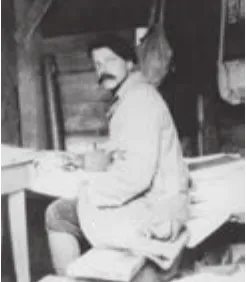
18 第一次世界大战期间克瑞在战壕中的照片/Photograph,Cret in trench, World War I
与克瑞关于公民建筑特性的观念直接相关的是一种信念,这是鲍扎教育体系的核心,即建筑师的职责是通过理解机构在社会中不断变化的功能来促进其演变。1913年印第安纳波利斯公共图书馆竞赛中,克瑞的获胜作品尤其说明了这点。
从历史上看,图书馆的功能是存储图书,使那些有权阅读的人获益。当然,那些有时间花在图书馆阅览室中的人可以阅读里面的书籍。因此,阅览室是图书馆最重要的房间。但是在20世纪初,阅览室的主导地位受到更为民主的家庭借阅观念的挑战。家庭借阅指的是将书从图书馆借出来,在家方便时阅读。重要的是,在印第安纳波利斯公共图书馆竞赛时,图书馆的传统功能已在不断变化。
因此并不奇怪,印第安纳波利斯公共图书馆竞赛对于是将阅览室赋予特权还是更激进地将借阅室赋予特权给予了模棱两可的说明。大多数参赛者选择设计传统的阅览室类型。然而,克瑞提出了一个绝妙的替代方案,正如剖面显示(图27),他按照惯例将阅览室放在二楼,但在其设计中,它们位于建筑物的侧翼而非主立面上。而且,令人惊叹的是,他将借阅台设置在了入口层和二层高度之间的夹层平台上。在那里,借阅台成为了建筑的标志性特征,当人们从入口前厅走上一小段楼梯时,它就能到达(图28)。此外,他的借阅室非常宽敞,有两层通高,周围有一圈阳台。该部分的面积比任务书要求的多了50%,但克瑞使该空间尺寸合理化,因为它可以兼做图书馆的交通大厅。
克瑞出色的设计技巧使他创造出一座推动图书馆类型发展的建筑。他将家庭借阅台作为建筑的特色,坚持了希望促进受教育的公民获得更多机会的价值观念。
尽管克瑞的理想根植于自身经历,但有趣的是,克瑞关于建筑和社会的理想与20世纪初中国的“五四运动”关于社会变革的诉求是一致的。在维拉·施瓦茨的《中国启蒙知识分子与1919年“五四运动”的遗产》一书中强调,参加该运动的中国知识分子提倡关于开化个人以及知识探索对社会进步重要性的新思想[2]。
在施瓦茨引用的众多著作中,有一篇是罗家伦(1897-1969,图29)在“五四运动”的核心期刊《新潮》上所写的:
“我们的思想革命旨在变奴性的思想为独立的思想,变专制的思想为民主的思想,变昏乱的思想为逻辑的思想。” 当然,这些语言比克瑞的更为尖锐,而且是写在中国社会和政治大混乱时期。但是,独立思考对良好社会建立的重要性在罗家伦的话语中引起了清晰的共鸣。
在北京大学人文系主任陈独秀(图30)的著作中,对解决社会问题的强调十分明显。陈独秀在1915年提出论点:“中国目前迫切需要的是在特定问题上有清晰思考能力的人而非热血青年。”作为中国留学生的老师,克瑞参与竞赛项目的方法以及他在其中探索公民机构逐步演变的可能性,与陈对“特定问题的清晰思考”有着明显的相似之处。
施瓦茨强调了清华大学教师在五四运动中的重要作用。值得注意的是,其中一位教授哲学的金岳霖(图31),是曾在宾夕法尼亚大学学习的建筑师梁思成的密友。当然,梁思成的父亲梁启超是本次运动的核心人物(图32)。还有林徽因也曾就读于宾夕法尼亚大学,她后来成为梁思成的妻子和建筑事业的合作者,她也为一些与中国启蒙有关的期刊撰稿(图33)。
何其有幸,克瑞可以教授带有如此背景从中国远道而来的学生;何其有幸,这些学生可以找到一位老师,就像他们一样相信一个重视教育、开明思想、对问题清晰思考的重要性的社会。
关于克瑞还有最后一点要说明,尽管他明白工作赋予了他社会价值,但他对自己的成就十分谦虚。1938年,他获得了美国建筑师协会(AIA)的最高荣誉金奖。他在致辞中说道:
“在建筑艺术中,集体努力比个人的努力更能体现时代的理想。也有一些贡献者,随着时间的推移,在历史长河中被淹没姓名,他们所做的贡献将归功于唯一留下姓名的人。能够成为创造我们这个时代建筑的工匠之一已经足够令人满足的了。”
这些言论透露出的不仅仅是他个人的谦虚,而且与克瑞的信念产生共鸣,即一个社会理想的形成需要许多人的贡献。每个人都有机会表达自己的想法,由此最好的想法就会浮现出来,这是多么重要。一个人认识到自己对社会的贡献远大于对自己声誉 (也许是短暂的声誉),这也非常重要。(感谢清华大学,特别感谢童明教授邀请我参加这次有关清华第一代留美建筑师的研讨会。此次展览和“觉醒的现代性”的文章强调了这些建筑师的工作是多么重要。我还要感谢我的同事和朋友赖德霖教授,是他对建筑的社会责任感的信念激励了我。)

19 美国国会大厦,华盛顿特区,1800-1865年/ United States Capitol, Washington. D.C, 1800-1865
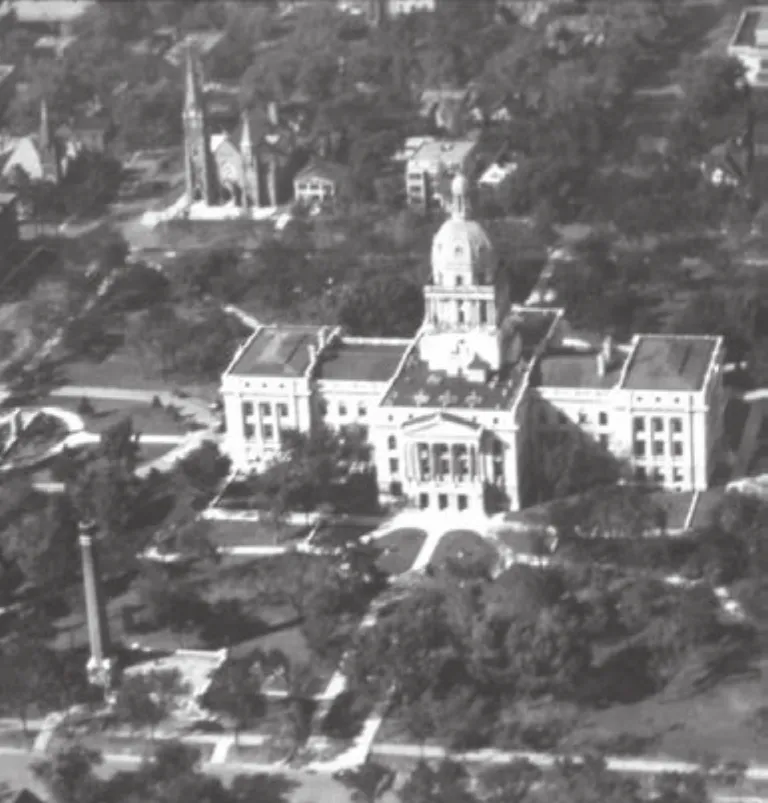
20 原先的内布拉斯加州议会大厦,1886年/Former Nebraska State Capitol, 1886
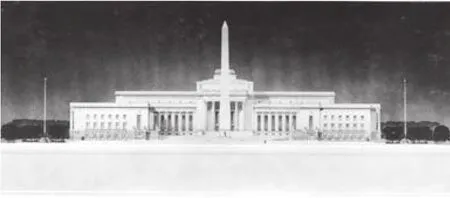
21 克瑞,1919年内布拉斯加州议会大厦竞赛立面/Cret,Nebraska State Capitol competition 1919, elevation drawing

22 克瑞,1919年内布拉斯加州议会大厦竞赛平面/Cret,Nebraska State Capitol competition 1919, plan

23 克瑞,内布拉斯加州议会大厦竞赛分解构图/Cret,Nebraska State Capitol competition, analytique

24 贝特拉姆·G·古德休,内布拉斯加州议会大厦,1920-1932年,鸟瞰/Bertram Grosvenor Goodhue, Nebraska State Capitol, 1920-1932, aerial view
Although Cret's ideas are rooted in his own history, it is interesting to speculate briefly about possible parallels between Cret's ideas about architecture and society and the intellectual ideas of the Chinese reform movement of the early 20th century called the May Fourth Movement. In her book,The Chinese Enlightenment Intellectuals and the Legacy of the May Fourth Movement of 1919,Vera Schwarcz stresses that the Chinese intellectuals who participated in this movement promoted new ideas about the importance of enlightened individuals and open intellectual inquiry to the progress of society[2].
Among the many writings that Schwarcz quotes is one by LUO Jialun (1897-1969, Fig 29) fromNew Tidethe key journal of the May Fourth Movement:
"Our thought revolution aims to change slavish mentality into independent thinking, to change autocratic mentality into egalitarian thinking, to change chaotic mentality into logical thinking."Of course this language is more strident than Cret's and was written at a time of great social and political chaos in China but none theless the importance of independent thinking for a good society resonates clearly in LUO's words.
His stress on solving social problems is clear also in the writings of CHEN Duxiu (Fig 30), who became dean of Humanities at Beijing University. CHEN argued in 1915 that "what China urgently needed instead of emotionally ardent patriots, were people who were capable of thinking clearly about specific problems". As a teacher of students from China,Cret's approach to competition programmes and his searching in them for possibilities for the progressive evolution of civic institutions have clear parallels to CHEN's "thinking clearly about speci fic problems"
Schwarcz underscored the important role that Tsinghua University faculty played in the May Fourth Movement. Signi ficantly, one of them, JIN Yuelin (Fig. 31),who taught philosophy, there was an intimate friend of architect LIANG Sicheng who studied at Penn. Of course, LIANG Qichao (Fig. 32), LIANG Sicheng's father, was a central figure in the movement. And LIN Huiyin, who also went to Penn and would become LIANG Sicheng's wife and architectural collaborator wrote for some of the journals associated with the Chinese Enlightenment (Fig. 33).
How fortunate for Cret that students from such a background came from China to study with him.And how fortunate for the students that they found a teacher who believed, as they did, in a society that valued education, open minded thought, and the importance of thinking clearly about problems.
There is one final point to make about Cret.Although he understood his work as giving him social value, he was modest about his achievements. In 1938 he was awarded the Gold Medal of the American Institute of Architects, its highest honour. In his acceptance speech he said:
"In the art of Architecture, collective effort counts more than individual industry in giving form to the ideals of a period. There are, [also], contributions which in time become anonymous and are apt to be ascribed to the one name which survives. To be one of the artisans who create the architecture of our time is satisfaction enough".
These remarks reveal much more than his personal modesty. They resonate with Cret's belief that the contributions of many people are necessary to give form to a society's ideals. How important then that every individual has the opportunity to express their ideas so that the best ideas may surface. How important too to realise that it is society to which one is contributing much more than to one's own, perhaps fleeting, reputation. (I would like to thank Tsinghua University and particularly Professor TONG Ming for including me in this symposium about the students of Tsinghua University who studied with Paul Cret at the University of Pennsylvania. The exhibition and the text"The Rise of Modernity" underscore how important the work of these architects is. I would also like to thank personally my colleague and friend Professor LAI Delin whose belief in the social responsibility of architecture has inspired me.)

26 克瑞,内布拉斯加州议会大厦竞赛总平面/Cret,Nebraska State Capitol competition site plan

27 克瑞,印第安纳波利斯公共图书馆剖面,印第安纳波利斯,1914-17年/Cret, Indianapolis Public Library, Indianapolis,1914-17, section

28 克瑞,印第安纳波利斯公共图书馆借阅室/Cret, Indianapolis Public Library, Delivery Room

29 罗家伦/LUO Jialun

30 陈独秀/CHEN Duxiu
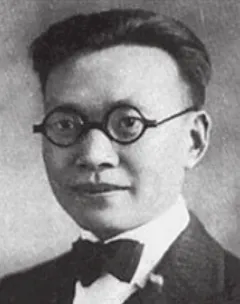
31 金岳霖/JIN Yuelin
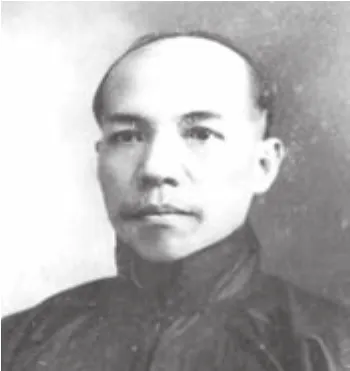
32 梁启超/LIANG Qichao
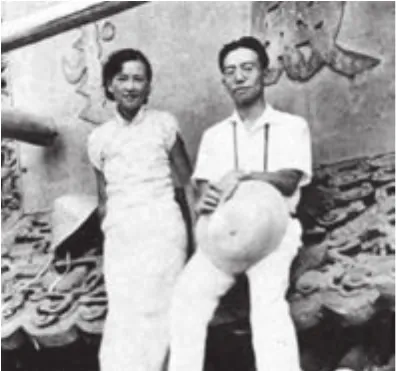
33 林徽因和梁思成/LIN Huiyin and LIANG Sicheng
注释/Notes
1)本文以我的书《保罗·克瑞的公民建筑》(剑桥大学出版社,1996)中的材料为基础,文中有关克瑞建筑和竞赛作品的资料和插图均源自这本书。关于“五四运动”中的中国知识分子的材料是基于我尚未发表的文章《知识分子的相似性:中国启蒙运动,保罗·克瑞的作品和来自中国的宾大学生》。该文章主要引用的文献来源请见参考文献[2-3]/This paper is based on material in my bookThe Civic Architecture of Paul Cret(Cambridge University Press, 1996) from which the Cret material and illustrations of Cret's buildings and of the competition entries are derived. The material on the Chinese intellectuals of the May Fourth movement is based on my unpublished paper "Intellectual Parallels: The Chinese Enlightenment, Paul Cret's work and the Penn students from China." The main texts referred to [2-3].
2)克瑞建筑的彩色图片是我自己提供的。赖德霖提供了中国知识分子和学生的照片。值得注意的是,克瑞参加竞赛时,常与美国建筑师合作。在泛美联盟总部竞赛中,他与阿尔伯特·凯尔西合作,在内布拉斯加州议会大厦和印第安纳波利斯公共图书馆竞赛中与赞特辛格、鲍里和曼德里合作。关于内布拉斯加州竞赛的详细讨论,请参阅参考文献[4]/The color images of Cret's building are my own. LAI Delin provided images of Chinese intellectuals and students. It should be noted that Paul Cret most often associated with American architects when he entered competitions. For the Pan American Union Building he associated with Albert Kelsey, and for the Nebraska and Indianapolis competitions with Zantzinger, Borie, and Medary. For an extended discussion of the Nebraska competition see my article which is Ref [4].

